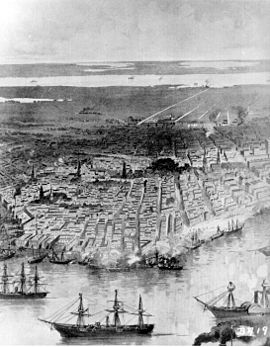Battle of New Orleans (Civil War)
| Capture of New Orleans | |||||||
|---|---|---|---|---|---|---|---|
| Part of the American Civil War | |||||||
 Panoramic view of New Orleans; Federal fleet at anchor in the river (c.1862) |
|||||||
|
|||||||
| Belligerents | |||||||
|
|
|
||||||
| Commanders and leaders | |||||||
|
David Farragut Benjamin Butler |
Mansfield Lovell | ||||||
| Units involved | |||||||
|
Department of the Gulf West Gulf Blockading Squadron |
Department No. 1 | ||||||
| Casualties and losses | |||||||
| none | none | ||||||
The capture of New Orleans (April 25 – May 1, 1862) during the American Civil War was an important event for the Union. Having fought past Forts Jackson and St. Philip, the Union was unopposed in its capture of the city itself, which was spared the destruction suffered by many other Southern cities. However, the controversial and confrontational administration of the city by its U.S. Army military governor caused lasting resentment. This capture of the largest Confederate city was a major turning point and an incident of international importance.
The history of New Orleans contrasts significantly with the histories of other cities that became part of the Confederate States of America. Because it was founded by the French and owned by Spain for a time, New Orleans had a more cosmopolitan culture and diverse population. Only 13 percent of the 1810 population was Anglo-American. The census population of that time was made up of mostly French speaking refugees from the Haitian Revolution, the French and Indian War, and French and Spanish Creoles along with some smuggled slaves. New Orleans also benefited more by the Industrial Revolution, international trade, and geographical position. Its position by the mouth of the Mississippi River, which drained an important part of the United States, made New Orleans one of the most significant transportation centers in the early United States before the establishment of railroad and road systems. Of particular significance were the inventions of the steamboat and the cotton gin. Before the steamboat, keelboat men bringing cargo downriver would break up their boats for lumber in New Orleans and travel overland back to Ohio or Illinois to repeat the process. Steamboats had enough power to move upstream against the current of the Mississippi, making two-way trade possible between New Orleans and the cities in the interior river network. With the end of the Napoleonic Wars in 1815, which greatly expanded international trade, and the development of the cotton gin, cotton became a valuable export product, adding to the volume of cargo moved through the city.
...
Wikipedia
